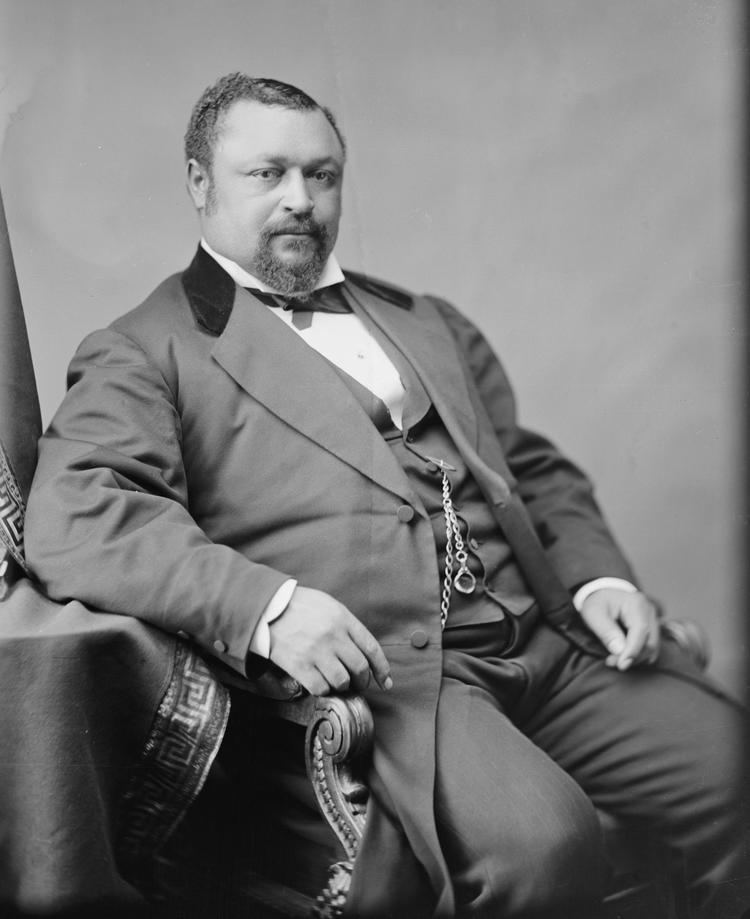Role Former U.S. senator | Name Blanche Bruce | |
 | ||
Full Name Blanche Kelso Bruce Born March 1, 1841Farmville, Virginia, U.S. ( 1841-03-01 ) Profession Politician, teacher, farmer Died March 17, 1898, Washington, D.C., United States Spouse Josephine Willson Bruce (m. 1878–1898) Parents Polly Bruce, Pettis Perkinson Similar People Hiram Rhodes Revels, Robert Smalls, Lawrence Otis Graham, Thaddeus Stevens | ||
Children Roscoe Conklin Bruce, Sr. | ||
Blanche bruce slave to senator
Blanche Kelso Bruce (March 1, 1841 – March 17, 1898) was an African-American politician who represented Mississippi as a Republican in the United States Senate from 1875 to 1881; of mixed race, he was the first elected black senator to serve a full term. Hiram R. Revels, also of Mississippi, was the first African American to serve in the U.S. Senate but did not complete a full term.
Contents
- Blanche bruce slave to senator
- Terry Adkins Blanche Bruce and the Lone Wolf Recital Corps At Osiris 2013
- Life and politics
- Relationship with other African Americans
- Marriage and family
- Honors and legacy
- References

Terry Adkins, Blanche Bruce and the Lone Wolf Recital Corps: At Osiris (2013)
Life and politics

Bruce was born into slavery in 1841 in Prince Edward County, Virginia near Farmville to Polly Bruce, an African-American woman who served as a domestic slave. His father was her master, Pettis Perkinson, a white Virginia planter. Bruce was treated comparatively well by his father, who educated him together with a legitimate half-brother. When Blanche Bruce was young, he played with his half-brother. His father legally freed Blanche and arranged for an apprenticeship so he could learn a trade.
Bruce taught school and attended for two years Oberlin College in Oberlin, Ohio. He next worked as a steamboat porter on the Mississippi River. In 1864, he moved to Hannibal, Missouri, where he established a school for black children.
In 1868, during Reconstruction, Bruce relocated to Bolivar near Cleveland in northwestern Mississippi, at which he purchased a Mississippi Delta plantation. He became a wealthy landowner of several thousand acres in the Mississippi Delta. He was appointed to the positions of Tallahatchie County registrar of voters and tax assessor before he won an election for sheriff in Bolivar County. He later was elected to other county positions, including tax collector and supervisor of education, while he also edited a local newspaper. He became sergeant-at-arms for the Mississippi State Senate in 1870.
In February 1874, Bruce was elected by the U. S. Senate, the second African American to serve in the upper house of Congress. On February 14, 1879, Bruce presided over the U.S. Senate, becoming the first African American (and the only former slave) to have done so. In 1880, James Z. George was elected to succeed Bruce.
At the 1880 Republican National Convention in Chicago, Bruce became the first African American to win any votes for national office at a major party's nominating convention, with eight votes for vice president. The presidential nominee that year was Ohio's James A. Garfield, who narrowly won election over the Democrat Winfield Scott Hancock.
In 1881, Bruce was appointed by President Garfield to be the Register of the Treasury, the first African American to have his signature featured on U.S. paper currency.
Bruce served by appointment as the District of Columbia recorder of deeds from 1890 to 1893; he was expected to yield fees of up to $30,000 per year. He also served on the District of Columbia Board of Trustees of Public Schools from 1892 to 1895. He was a participant in the March 5, 1897 meeting to celebrate the memory of Frederick Douglass and the American Negro Academy led by Alexander Crummell. He was appointed as Register of the Treasury a second time in 1897 by President William McKinley and served until his death in 1898.
Relationship with other African Americans
On the Bruce plantation in Mississippi, black sharecroppers lived in "flimsy wooden shacks," working in the same oppressive conditions as on white-owned estates.
After his Senate term expired, Bruce remained in Washington, D.C., secured a succession of Republican patronage jobs and stumped for Republican candidates across the country. There, he also acquired a large townhouse and summer home, and presided over black high society.
One newspaper wrote that Bruce did not approve of the designation "colored men." He often said, "I am a Negro and proud of it."
Marriage and family
On June 24, 1878, Bruce married Josephine Beal Willson (1853 – February 15, 1923), a fair-skinned socialite of Cleveland, Ohio, amid great publicity; the couple traveled to Europe for a four-month honeymoon.
Their only child, Roscoe Conkling Bruce, was born in 1879. He was named for U. S. Senator Roscoe Conkling of New York, Bruce's mentor in the Senate. In 2002, scholar Molefi Kete Asante listed Blanche Bruce on his list of 100 Greatest African Americans.
In the fall of 1899, Josephine Bruce, accepted the position of lady principal at Tuskegee Institute in Tuskegee, Alabama. While visiting Josephine at Tuskegee, during the summer break of his senior year at Harvard, Roscoe Bruce met Booker T. Washington and secured a position at Tuskegee as head of the Academic Department.
Honors and legacy
In July 1898, the District of Columbia public school trustees ordered that a then new public school building on Marshall Street be named the Bruce School in his honor. Marshall Street later became Kenyon Street and the Bruce School became Caesar Chavez Prep Middle School in 2009, named for the Mexican-America labor organizer Cesar Chavez. The Bruce School was combined with the James Monroe school to create Bruce-Monroe, located on Capitol Hill. |
